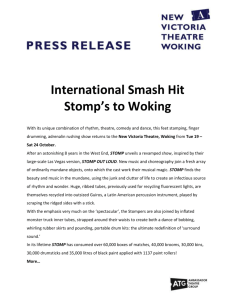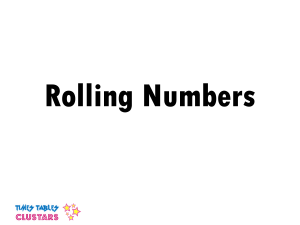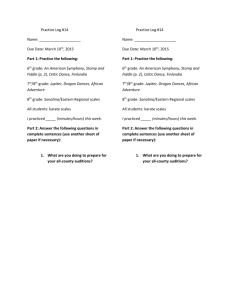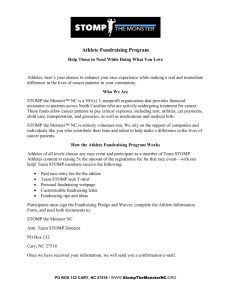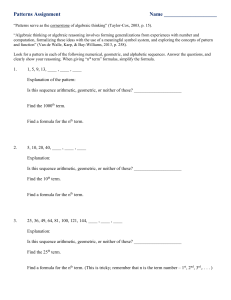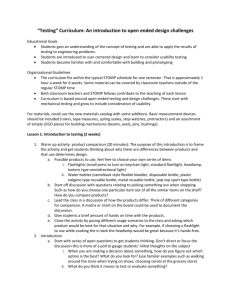What is a “Stomp Box”? - Jan
advertisement
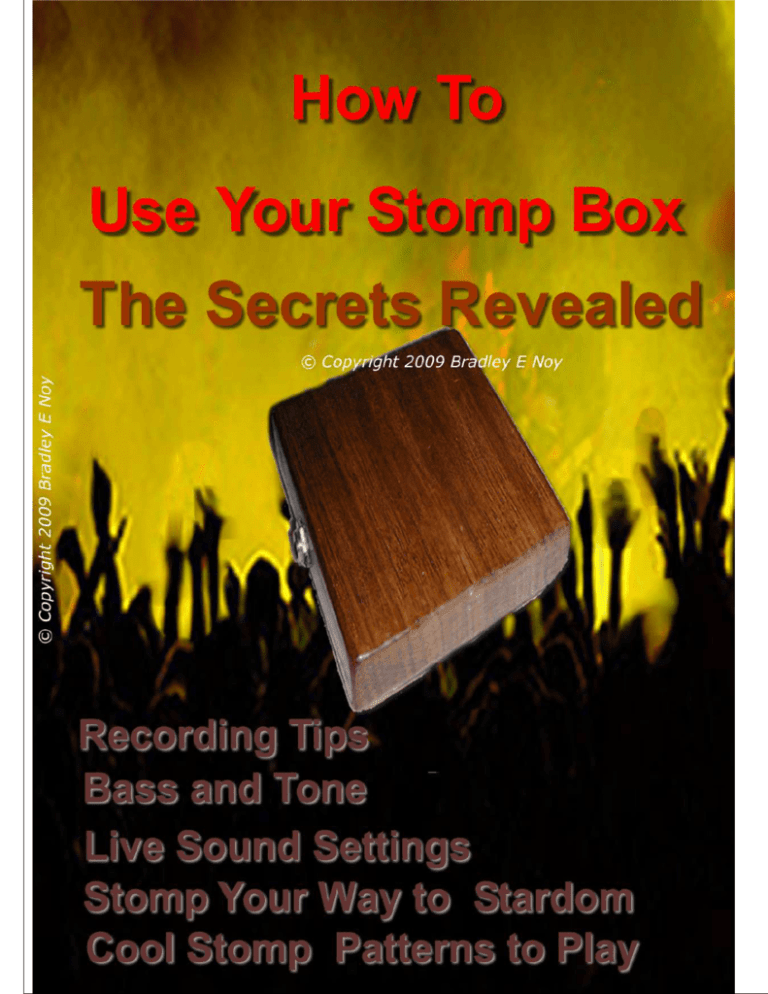
1|Page © Copyright 2009 Bradley E Noy Limits of Liability/Disclaimer of Warranty: The author and publisher of this book and accompanying materials have used their best efforts in preparing this book. The author and publisher make no representation or warranty with respect to accuracy, applicability, fitness, or completeness of the contents of this book. They disclaim any warranties (expressed or implied), merchantability, or fitness for any particular purpose. The author and publisher shall in no event be held liable for any loss or damages including, but not limited to special, incidental, consequential or other damages. As always, the advice of a competent legal, tax, accounting or other professional should be sought. This manual contains material protected under international copyright law please contact the publisher to obtain permission to copy or reproduce the content electronically, digitally, manually any content or information provided in this book. About The Author Bradley Noy Bradley Noy has been a professional musician/song writer, sound engineer and software engineer for over 20 years. Bradley has written many books and step by step instructional and operational manuals for the audio visual and music industries. Bradley Noy has also played with many well known artists. Currently at the time of writing this book he was recording and touring with Jan-Marie and the Band. He has worked as a Design Engineer for JBD Productions, Sony, TCP and Chief Engineer for EO Designs. Bradley has worked around the world for many companies as an Engineer in the music and audio visual industries. He has worked on projects like the Sydney Opera House, Santos, Sony AV Central, State Tennis Centre, Sydney International Airport, Melbourne Airport, Brisbane Airport, Mackay & Brisbane Convention Centre, Gold Coast Convention Center, Brisbane Entertainment Centre, iSoft, IBA Health, IBM, Conrad Jupiter’s Casino, Treasuries Casino, Brolga Theatre and Convention Centre, Southbank, Queen St Mall, Hamilton Island plus many more projects. 2|Page © Copyright 2009 Bradley E Noy Table of Contents o What is a “Stomp Box”? o How to use a stomp box o Setting up your stomp box o Bass and tone effects o Recording tips o Learning different styles o Benefits of playing the stomp box o Where to buy your stomp box 3|Page © Copyright 2009 Bradley E Noy What is an acoustic “Stomp Box”? A stomp box is a percussion instrument made of a number of materials the most common material is timber. Some acoustic stomp boxes are made from plastic and metal. Acoustic stomp boxes started out as a timber box similar to a cigar box, usually amplified using a microphone placed inside the box. Modern acoustic stomp boxes use crystal pickups or vibration pickups connected to an amplifier. Acoustic stomp boxes are used by musicians to produce low deep sounds similar to a percussionist’s bass drum. Most stomp boxes are used by singers and guitarists. The acoustic stomp box was used by ragtime and blues musicians to add basic bass beats to their music. Modern day musicians still use the same principles and use them for deep bass rhythms. Sound engineers also use them in radio and film to get a variety sounds from door knocking to bass drum effects. Today many famous guitarists and singers use them live on stage to add effects and depth to their music. Solo artists mainly use the acoustic stomp box to add rhythm to their music. Tip: What is an acoustic “Stomp Box”? Stomp boxes are usually made from timber or plastic with a microphone pickup inside this allows a performer such as a singer or guitar player to create a simple rhythm that sounds like a bass drum. © Copyright 2009 Bradley E Noy 4|Page © Copyright 2009 Bradley E Noy How to use a stomp box There are many ways to play a stomp box percussion instrument to produce many different sounds. Hitting the stomp box with your foot with a shoe will usually create a low deep bass sound like a percussionist’s bass drum. Different soles on your shoes also create different tones. Playing the stomp box with the front of your foot This produces a bass sound and is used mostly when playing the guitar or other stringed instrument. Playing the stomp box with the back of your foot This produces a bass sound and is used mostly when playing the guitar. 5|Page © Copyright 2009 Bradley E Noy Playing the stomp box with your hand This produces knocking, tapping and banging like a hand drum. Different sounds can be made using this method. Sound is used mostly by a percussionist for special effects in movies. Playing the stomp box with percussion mallet sticks This produces a knocking sound or a type of wood block sound and is used mainly by a percussionist as well as sound engineers making special sound effects in movies. Tip: How to use a stomp box Singers, musicians and guitarists use their foot to play a stomp box; this creates a simple rhythm that sounds like a bass drum. © Copyright 2009 Bradley E Noy 6|Page © Copyright 2009 Bradley E Noy Setting up your stomp box The stomp box should be connected to a separate amplified channel with its own tone controls. For sound engineers, the input channel on the mixing desk is where the acoustic stomp box is plugged into. Adjust the bass frequencies to a louder setting and the high and mid frequencies to a lower setting. Parts needed Stomp box ¼” (6.5mm) jack guitar lead mono Amplifier with tone control Optional effects pedal And your rhythmic foot + + + + Stomp Box + Lead + Optional Effects + Lead + Amplifier 7|Page © Copyright 2009 Bradley E Noy Making Sounds Turn the amplifier volume to low and the input presets / channel volume to low Turn the bass tone up and the treble and mid tones down on the stomp box input channel on the amplifier or mixing desk Place the acoustic stomp box on the floor, plug in one end of the mono 6.5mm or ¼“ jack lead into the stomp box and the other end of the 6.5mm or ¼“ jack lead to the amplifier or through an effects pedal to the amplifier Turn the amplifier on and place the ball of your foot on the acoustic stomp box Tap your foot rhythmically Increase the volume on the amplifier using presents/channel volume and master volume slowly till you hear the sound of the acoustic stomp box Adjusting the tone controls for more bass and less treble also experimenting with these settings can give you different percussion sounds. Tip: Setting up your stomp box Adjusting the tone controls can give you different Percussion sounds. © Copyright 2009 Bradley E Noy 8|Page © Copyright 2009 Bradley E Noy Bass and Tone Effects Stomp Box with Super Bass by JBD Productions www.jbdproductions.com.au Adjusting the bass tone controls will make the stomp box sound like a bass drum or subsonic percussion sound. Frequency range is between 20-500Hz. Adjusting the midrange tone controls will produce a dynamic sharp sound. Frequency range is between 400-1000Hz. Adjusting the treble tone controls will produce a wood block or click sound. Using different soles on your shoes can change the sound I use a rubber sole. Reverb Adding reverberation to the stomp box changes the perception of sound. No reverberation reduces your sound capacity and makes your stomp box sound like it is outside in an open field. Short reverberation can make your stomp box sound like it is in a small room. Longer reverberations make you sound like you are in a large cathedral. Delay Delay can make your stomp box sound multiply and it sounds like you are stomping many times when you only stomp once. Other Effects Using guitar effects pedals and experimenting with the effects. Having a signature sound is one way your fans can identify and remember you. Tip: Bass Tones and Effects Use a guitar effects pedal with your stomp box to create a unique sound. © Copyright 2009 Bradley E Noy 9|Page © Copyright 2009 Bradley E Noy Recording tips There are so many different recording techniques. For the stomp box, boost low bass frequencies (20Hz to 300Hz) up as much as possible without producing distortion. Minimise the amount of high and mid frequencies (500Hz – 20KHz). Equalizers will help you to find the correct range of frequencies you desire for recording. Don’t forget you can add stereo panning effects, reverb, delay and phase effects. For a wood block sound or a click sound try turning the mid tones up higher. Multi track recording is the best way to record as you can play an instrument like a guitar, sing and stomp and record them all at the same time on individual channels. The guitar on channel one, sing on channel two, and stomp box on channel three. On cheaper multi track recorders you have to perform the recording three times and save each track you have recorded to a new channel. If you make a mistake when using the multi track recorder; say on the stomp box channel three, you can record a new stomp box on channel four and delete channel three or you can adjust the levels during the mix down. Remember to adjust the input/gain level on the recording equipment so that the signal is not redlining as well as the peak LED or level meter is not clipping or distorting. The level should be just under this level but definitely not above under any circumstances. I like to use a metronome to keep the timing tight. There are so many different recording techniques. Tip: Recording tips Multi track recording is the best way to record your stomp box. © Copyright 2009 Bradley E Noy 10 | P a g e © Copyright 2009 Bradley E Noy Learning different styles Playing with the heel or toe method Using two acoustic stomp boxes together you can play double stomp beats just by using heel on one stomp box and then the toe area on the other acoustic stomp box. Using two feet can make cool syncopated rhythms or paradiddles. Playing with two acoustic stomp boxes you can also set different tones for each stomp box to give you a better dynamic range to experiment with. Practice makes perfect Practice your acoustic stomp box with a metronome this will help you keep in time. If you sing, play guitar and practice with your instruments, you can try to do double beats and single beats. For example: when counting 1, 2, 3, 4, stomp on the red numbers. 4/4 1 2 3 4 |1 2 3 4|1 2 3 4|1 2 3 4| - count 1,2,3,4 and play on 1,2,3,4 4/4 1 2 3 4 |1 2 3 4|1 2 3 4|1 2 3 4| - count 1,2,3,4 and play on 1 and 3 4/4 1 2 3 4 |1 2 3 4|1 2 3 4|1 2 3 4| - count 1,2,3,4 and play on 1 and 4 4/4 1&2&3&4&|1&2&3&4&|1&2&3&4&|count 1&,2&,3&,4& Play the red1,4& When using two stomp boxes to perform a paradiddles - (L) Left Foot (R) Right Foot < < < < < < < < 4/4 RLRR LRLL RLRR LRLL RLRR LRLL RLRR LRLL When playing a paradiddle the 1st beat of every 4 beats is accented which means you need to stomp harder on that particular note. You can even come up with some of your own ways to play different beats and styles on your stomp box, Tip: Practice makes perfect Practice playing your acoustic stomp box with a metronome. © Copyright 2009 Bradley E Noy 11 | P a g e © Copyright 2009 Bradley E Noy Benefits of playing the stomp box Using your stomp box will give you a rhythmic bass sound playing in time with your music and will enhance and compliment the sound. Your stomp box will help you keep in time and if you have a band will help all of your other members keep in time as well. If you were just playing your guitar then you can add a percussion sound which will give your tunes a whole new dimension. It is portable and lightweight as well as rugged and compact so you can take it to any gig with you or even travel on a plane with it without having to take a big bass drum with you. The stomp box is great tool for any musician to help improve their stage performance and give their fans a good solid beat to dance to. You will never need to change the batteries because this unit does not need any batteries whatsoever. Your stomp box is designed to stomp on so will be able to handle the rigours of touring and gigging around the place. A stomp box is a great substitute for a drummer or a band if you are unable to travel or perform with a band. The stomp box can be a great crowd pleasure especially if you have good rhythm skills on the guitar. For more information see the web links below www.myspace.com/bradleyenoy www.jbdproductions.com.au www.tizzaa.com/stompbox www.myspace.com/janmarieandtheband 12 | P a g e © Copyright 2009 Bradley E Noy Where to buy your stomp box We recommend the Jan-Marie Signature Stomp Box with Super Bass supplied by JBD Productions and the Bradley Noy Super Bass Stomp Box supplied by Bradley Noy. Click here to buy your stomp box or find out more information about what range of stomp boxes are available for purchase. www.tizzaa.com/stompbox . More designs are in currently in the pipeline; please join our mailing list to keep updated with our latest products and special offers and giveaways. www.tizzaa.com/stompbox To be eligible for our special offers and giveaways please quote the following code during your purchase or when you join our mailing list. You could win a free guitar lead or other prizes including a stomp box just for joining our mailing list. We have monthly giveaways to our members. Discount Code = ebookstomp5268854 Tip: Why you should buy a stomp box with super bass? The super bass is a special added feature that no other stomp box has got and it has been especially designed for you by a percussionist, drummer and audio engineer for your stomping pleasure! © Copyright 2009 Bradley E Noy 13 | P a g e © Copyright 2009 Bradley E Noy

